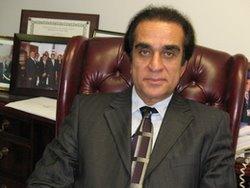
Dr. Reza Khanbilvardi, Director, NOAA-CREST Center
Aims to Become ‘National Center’ Serving Government, Academic and Scientific Communities
The NOAA-Cooperative Remote Sensing Science and Technology Center (NOAA-CREST) has begun its second decade of operation, supported by a new five-year, $15 million grant from the National Oceanic and Atmospheric Administration.
The center, which is based at The City College of New York and includes four other university partner institutions in California, Maryland, Virginia and Puerto Rico, aims to become an international and national center that will serve government agencies as well as the academic and scientific communities.
“In less than 10 years, NOAA-CREST has been able to establish itself as one of the country’s premier research centers,” said Dr. Reza Khanbilvardi, the center’s director and a NOAA-Chair Professor of Civil Engineering in CCNY’s Grove School of Engineering. “Most of our graduates are finding jobs before they graduate. Our research products are being used not only by NOAA, but by other agencies at the federal, state and local level, such as NASA and the EPA.”
NOAA-CREST was one of five cooperative science centers established nationwide through NOAA’s Educational Partnership Program with minority-serving institutions. Its research agenda is focused along four broadly based and interconnected themes: climate; weather and atmosphere; water resources and land processes; and ocean and coastal waters.
Besides CCNY and five other CUNY colleges, member institutions include Hampton University, University of Puerto Rico, California State University – Los Angeles and University of Maryland – Baltimore County.
The center has established a proven track record in recruiting, educating, training and graduating students from diverse backgrounds. To date, it has produced 350 graduates, 82 percent of whom are from groups underrepresented in the remote sensing sciences.
Its education programs, which run from kindergarten through PhD training, offer rigorous academic programs complemented by hands-on participation in state-of-the-art research tied to NOAA interests. Partnerships among CREST faculty, NOAA scientists and industrial partners Raytheon, Northrup Grumman and ERT Inc. enhance CREST activities by engaging scientists from off campus as co-mentors for CREST students.
Under the new grant, NOAA-CREST will continue to address NOAA’s goals of increasing environmental literacy and developing a skilled and diverse workforce. It has developed a conceptual model to prepare, encourage, engage, educate and employ students in NOAA-related sciences while increasing environmental literacy among professionals and the public.
In addition, the CREST center has a robust research agenda with 18 major projects involving 104 tasks now underway. CREST scientists, including 40 CUNY scientists and faculty members, are conducting these investigations in collaboration with more than 40 NOAA scientists and 15 Advisory Board Members. To date, CREST scientists and students have published more than 150 papers in peer-reviewed journals and presented at more than 300 scientific conferences in the United States and abroad.
Professor Khanbilvardi expects the center’s research output to grow over the next five years thanks to investments in infrastructure and several key faculty hires. “We have built a unique research infrastructure and assembled a great team of well-known scientists and faculty,” he said. “Together, they have enabled us to gain recognition as one of the leading technology-driven science centers for remote sensing of the earth in the country.”
The center owns and operates an array of sophisticated instrumentation that addresses all four remote sensing monitoring thrusts – air and climate; coastal and ocean waters; land, and hydrology – and offers regional and local data compilation and analysis capabilities. They include:
• The Microwave Observation Unit, which measures snowmelt, soil conditions and tropospheric weather conditions.
• The Long Island Sound Coastal Observation Unit, which is the only facility of its kind in the United States that measures radiance from coastal waters.
• A satellite earth observation station that receives and analyzes data directly from polar orbiting and geostationary satellites.
• NYC MetNet, a network of sensors that measures air quality in New York City and the New York metropolitan region.
Other facilities include: the CREST LIDAR Network, which spans from New York to Puerto Rico; computational, GIS and UNIX laboratories, and a mobile LIDAR laboratory.
In addition, several internationally prominent researchers on the Grove School of Engineering and City College Division of Sciences faculty have affiliated with NOAA-CREST. They include Dr. William Rossow, distinguished professor of electrical engineering; Dr. Jorge González, professor of mechanical engineering; Dr. Charles Vörösmarty, professor of civil engineering, and Dr. Kyle McDonald, professor of earth and atmospheric sciences.
The center envisions becoming the national remote sensing of earth institute for the United States, especially the Northeast, over the next decade. It expects to provide research and training that will be used by government agencies, scientists and academics. Models being developed by CREST scientists will address global and regional issues related to climate change including: disaster management, water resources assessment, coastal water management and severe storm tracking.
CREST also is working to expand its education agenda beyond providing support for students pursuing bachelors, masters and PhD degrees. It aims to provide a “K (kindergarten) to grey” menu of offerings that will include: professional development for engineers; pre-service and in-service training for teachers; summer research training for high school students through paid internships, and science enrichment activities for younger students.
On the Internet:
NOAA-CREST Center
http://crest.ccny.cuny.edu/
MEDIA CONTACT
Ellis Simon
p: 212.650.6460
e:
es%69m%6fn@ccny.cuny
.%65du" rel="nofollow">
esimon@ccny.cuny.edu